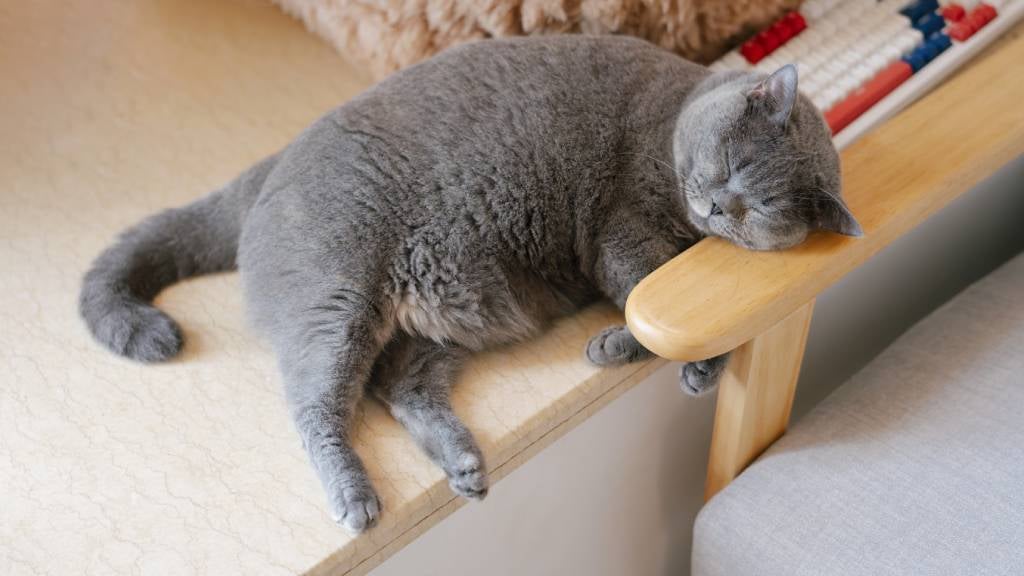Quick take
- Around 32% of Aussie cats are overweight or obese, according to an SBS article
- Extra weight can cause diabetes, arthritis, and shorter lifespans
- Gradual diet changes and daily play are safest for weight loss
- Regular monitoring helps catch problems before they become serious
- Vets can tailor diet and exercise plans for long-term success
Understanding cat obesity in Australia
Cat obesity is a growing concern in Australia, with studies showing around 32% of domestic cats are overweight or obese. Just like in humans, excess weight in cats can lead to serious health issues such as diabetes, arthritis, heart disease, and a shorter lifespan.
Recognising the problem early is key. Cats are super clever at hiding discomfort, which makes it harder to spot without regular monitoring.
Signs your cat may be overweight
Here are some key indicators to watch for:
- Visible fat deposits: look around the abdomen and base of the tail
- Difficulty grooming: overweight cats may struggle to reach all areas of their body
- Lethargy: less active or playful than usual
- Rapid weight gain: noticeable increase in body weight over months
- Difficulty jumping or climbing: cats may avoid high surfaces they previously enjoyed
A simple test: gently feel your cat’s ribs. You should be able to feel them without pressing hard; if you can’t, your cat may be overweight.
Causes of cat obesity
Several factors contribute to overweight cats, including:
- Overfeeding: free-feeding or too many treats
- High-calorie diets: some commercial cat foods are calorie-dense
- Lack of exercise: indoor cats often get limited physical activity
- Medical conditions: hypothyroidism or other metabolic disorders may contribute
Related: Sign of dehydration in dogs and cats: Prevention and care tips
How to manage your cat’s weight safely
1. Adjust diet gradually
- Switch to a measured feeding routine instead of free feeding
- Consider weight-control cat food formulated to reduce calories while keeping cats satisfied
- Avoid drastic calorie restriction – slow and steady weight loss is safest
2. Increase physical activity
- Use toys that encourage movement, such as feather wands
- Create vertical spaces like cat trees to encourage climbing
- Play in short, frequent sessions – even 5–10 minutes a few times a day helps
3. Monitor progress regularly
- Weigh your cat weekly and track progress
- Take note of behavioural changes and energy levels
- Consult your vet if weight loss is too slow or if your cat loses weight unexpectedly
4. Avoid unhealthy shortcuts
- Do not skip meals or reduce food drastically; this can lead to nutrient deficiencies
- Avoid giving high-calorie treats; use interactive play as a reward instead
- Do not attempt “fad diets” not approved by vets
When to see the vet
If your cat is overweight or you notice any rapid changes in weight, schedule a check-up. Vets can:
- Assess body condition score accurately
- Check for underlying medical conditions contributing to weight gain
- Develop a tailored diet and exercise plan for safe weight loss
Learn more about cat health: A guide to cat dental care: Tips for healthy teeth and gums
Tips to keep your cat at a healthy weight
- Feed measured portions at scheduled times
- Choose nutritionally balanced foods appropriate for age and lifestyle
- Encourage daily play and activity
- Monitor weight monthly and adjust feeding as needed
- Keep treats minimal and healthy – e.g., freeze-dried meat
Learn more about cat care: Why do cats wag their tails? Understanding cat tail language
Final thoughts
Maintaining a healthy weight is vital for your cat’s long-term health and happiness. With small, consistent changes in diet, play, and monitoring, most cats can achieve a safe weight and enjoy a more energetic, comfortable life.
Keep your fluffy feline covered with Buddy
While you’re working on your fluffy family member’s nutrition and getting their health on track, consider whether Buddy Pet Insurance may be something worth considering to help protect your pet and your pocket from unexpected vet visits. Get a quote today and protect your feline friend with Buddy.
FAQsFrequently Asked Questions about cat obesity
Feeling curious about commonly asked questions about cat obesity? Fear not, we have the answers to help you get your cuddly cat in shape safely.
How do I know if my cat is overweight?
You should be able to feel your cat’s ribs without pressing hard. If not, they may be overweight. Other signs include fat deposits, difficulty grooming, and lethargy.
What is a healthy cat diet?
A balanced diet with controlled portions is best for any pet. Weight-control cat foods can help reduce calories while keeping cats satisfied.
How fast should a cat lose weight?
Slow and steady is safest when it comes to reducing body mass and fat. Rapid weight loss can cause liver problems. Always aim for gradual changes.
Can indoor cats still lose weight?
Yes, indoor cats can reach a healthy weight. Use play sessions, climbing trees, and puzzle feeders to keep indoor cats active and burning energy.
7 Nov 2025

